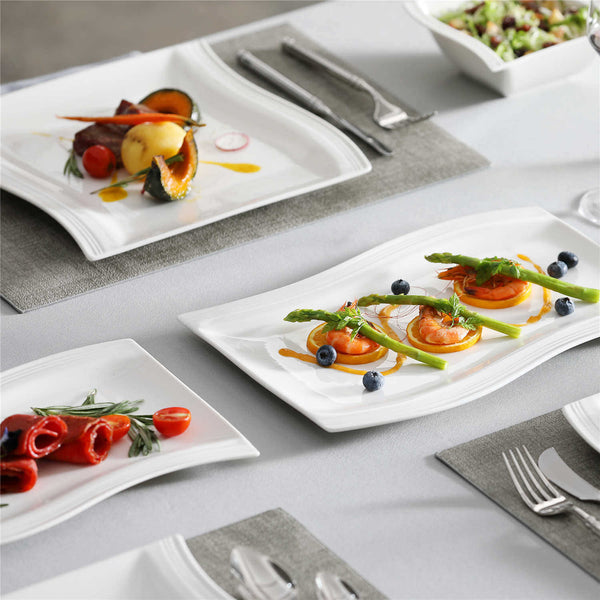Ceramic vs Porcelain: The 5 Differences You Should Know
Navigation
- What are the differences between ceramic dinnerware and porcelain dinnerware?
- How does the material affect the price?
- Are there any differences in durability?
- What are the other differences?
The terms "porcelain and ceramics" are often used interchangeably. Porcelain and ceramic dinnerware are similarly manufactured from baked clays, though what splits them is their durability and density. There are many differences between ceramic and porcelain dinnerware. Ceramic and porcelain are the most durable dinnerware materials that leave many of us undecided about which one to choose. Both have their own features, usages, pros and cons to help you choose as per your requirement. But what else makes these two dinnerware materials differ?
Check out this guide to learn more about how ceramic vs porcelain dinnerware differ!
What are the differences between ceramic dinnerware and porcelain dinnerware?
The major difference between ceramic and porcelain lies in their crafting. Ceramic dinnerware has a variety of options which include earthenware, stoneware, and porcelain. Porcelain dinnerware is made from more refined clay and it's fired at higher temperatures which makes it denser and more durable than ceramic. Porcelain is harder, tougher, denser, and less porous than ceramic. It also has a very little absorption rate - making it nearly impervious to water damage, even after prolonged exposure. Porcelain dinnerware develops a hard, glass-like, and translucent surface, after the firing. Porcelain dinnerware is more expensive, much rarer, and harder to find than ceramic. Porcelain dinnerware gives a lavish ambiance to your dining table with its classy aesthetics.
How does the material affect the price?
When it comes to the cost of ceramic vs porcelain dinnerware - porcelain is more expensive than ceramic. If you're really on a budget, then it is likely that ceramic will be a more affordable option. This makes ceramic dinnerware more cost-effective and affordable for many households and businesses. But if you need to add a classy touch to the dining table décor - nothing can beat porcelain as quality has a price.
Are there any differences in durability?
You must be wondering, is porcelain dinnerware more durable? Or should you go for the ceramic one? When it comes to choosing ceramic vs porcelain dinnerware, porcelain is absolutely more durable. What makes porcelain dinnerware more wear-resistant is the high temperature at which it is fired. Glazed ceramic dinnerware can also be durable, but porcelain is typically more lasting.
Porcelain tableware is not delicate but also very strong. But when it comes to durability - porcelain dinnerware is on the top. Porcelain dinnerware is likely a better choice than ceramic dinnerware because it is harder to break. Porcelain absorbs less water which also adds more longevity to it. It is more hard-wearing than ceramic dinnerware.

What are the other differences?
There are a number of differences between ceramic and porcelain dinnerware apart from durability. Both dinnerware differs on the basis of maintenance, density, cost, crafting procedure, and water and slip resistance.
Crafting of Ceramic VS Porcelain Dinnerware
Ceramic dinnerware has a wide range including earthenware, stoneware, and porcelain. Whereas, porcelain dinnerware is dinnerware made of a fine-particle clay - usually kaolin, feldspar, and bone ash - which is fired at a higher temperature to give it a glossy look. Porcelain dinnerware is known for its whiteness, translucency, hardness and strength, and higher resistance to thermal shock. Porcelain comes in a variety of types such as Bone China, soft-paste porcelain, and hard-paste porcelain. It has a very high level of translucency and whiteness.
Appearance
Porcelain dinnerware is super durable and nonporous - having a thinner and more delicate design and a translucent appearance. This dinnerware has a very lavish and upscale look which makes it more loved and recommended for formal dining. However, you can use them for everyday dining as well. Moreover, you can easily put the porcelain dinnerware in the dishwasher without any risk of breakage or scratching. Most of the porcelain dinnerware pieces are microwavable unless the manufacturer states any instructions.
Density and Durability
Porcelain dinnerware is fired at higher temperatures for a longer period. This makes porcelain dinnerware more durable and denser. Whereas, ceramic dinnerware is fired for a comparatively less time period and so proves to be more delicate. It is also opaque and thicker than ceramic.
Usage
Ceramic dinnerware is more appropriate for casual, everyday dining and place settings whereas porcelain dinnerware is perfect for formal dining or occasions.
Cost
Ceramics can be much cheaper than porcelain. However, the best ceramic dinnerware in terms of quality can be on par with the cost of dinnerware porcelain. You can pay a higher price for better quality, durability, and sleek appearance of porcelain dinnerware.
Final Thoughts
There are various features of porcelain and ceramic dinnerware, but there's no denying that each one can be a great addition to your dinnerware collection. It's just always a good idea to weigh your requirements and budget before making a decision. Choosing between ceramic and porcelain dinnerware can be an important decision. The main difference between ceramic and porcelain dinnerware is that ceramic dinnerware is opaque and thicker than porcelain dinnerware which has a delicate and translucent appearance. Furthermore, ceramic dinnerware is a better pick for casual dining while porcelain dinnerware is best for formal dining.
Read More
- Porcelain Dinnerware Bowls: Your Ultimate Guide to Choosing the Right Type
- Porcelain Dinnerware vs. Stoneware: Which One Is Better?
- What Is The Best Material For Everyday Dishes? (Updated For 2023)
- Porcelain Plates in the Oven: What You Need to Know
- The Ultimate Guide to Caring for Bone China Dinnerware for Long-Lasting Durability









Thank you for reaching out to us and sharing your needs. We understand how important it is to have tableware that suits your specific requirements.
Our porcelain dinnerware sets are known for their durability and quality, but they do tend to be heavier. Given your condition, we would highly recommend considering our bone china collection. Bone china is exceptionally light, making it a perfect choice for those with arthritis or other hand issues.
If you have any further questions or need assistance with your purchase, please don’t hesitate to contact us. We’re here to help!
I have arthritis in my hands and l need light crockery. Can I get porcelain that is light or would ceramic be lighter. Please advise
Leave a comment